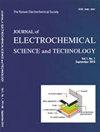Experiment and Electro-Thermo-Chemical Modeling on Rapid Resistive Discharge of Large-Capacity Lithium Ion Battery
IF 3
4区 工程技术
Q3 ELECTROCHEMISTRY
Journal of electrochemical science and technology
Pub Date : 2022-02-10
DOI:10.33961/jecst.2021.00661
引用次数: 0
Abstract
Heat generation and temperature of a battery is usually presented by an equation of current. This means that we need to adopt time domain calculation to obtain thermal characteristics of the battery. To avoid the complicated calculations using time domain, ‘state of charge (SOC)’ can be used as an independent variable. A SOC based calculation method is elucidated through the comparison between the calculated results and experimental results together. Experiments are carried for rapid resistive discharge of a large-capacitive lithium secondary battery to evaluate variations of cell potential, current and temperature. Calculations are performed based on open-circuit cell potential (SOC,T), internal resistance (SOC,T) and entropy (SOC) with specific heat capacity.大容量锂离子电池快速电阻放电实验及电热化学模型
电池的发热和温度通常由电流方程表示。这意味着我们需要采用时域计算来获得电池的热特性。为了避免使用时域进行复杂的计算,“充电状态(SOC)”可以用作自变量。通过计算结果与实验结果的比较,阐明了一种基于SOC的计算方法。对大容量锂二次电池的快速电阻放电进行了实验,以评估电池电势、电流和温度的变化。基于开路电池电势(SOC,T)、内阻(SOC,T)和比热容熵(SOC)进行计算。
本文章由计算机程序翻译,如有差异,请以英文原文为准。
求助全文
约1分钟内获得全文
求助全文
来源期刊

Journal of electrochemical science and technology
ELECTROCHEMISTRY-
CiteScore
6.30
自引率
8.10%
发文量
44
期刊介绍:
Covering fields:
- Batteries and Energy Storage
- Biological Electrochemistry
- Corrosion Science and Technology
- Electroanalytical Chemistry and Sensor Technology
- Electrocatalysis
- Electrochemical Capacitors & Supercapcitors
- Electrochemical Engineering
- Electrodeposition and Surface Treatment
- Environmental Science and Technology
- Fuel Cells
- Material Electrochemistry
- Molecular Electrochemistry and Organic Electrochemistry
- Physical Electrochemistry
- Solar Energy Conversion and Photoelectrochemistry
 求助内容:
求助内容: 应助结果提醒方式:
应助结果提醒方式:


